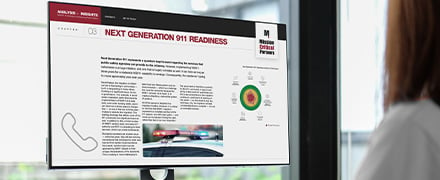Change for 911 is Inevitable, and That's a Good Thing
Posted on February 15, 2018 by John Spearly

Change is an interesting concept, a philosophical tug of war if you will. It can be viewed as positive or negative, exciting or demoralizing, vital or unnecessary, and easy or difficult, depending on one’s perspective. The one thing that universally can be said about change is that it is inevitable. As the ancient philosopher Heraclitus once opined, “The only thing that is constant is change.”
Change also is disruptive, which is why many people and organizations try to avoid it. The status quo is comfortable. It is known, and the unknown tends to make people uncomfortable at best, fearful at worst. For many people and organizations, accepting change is akin to declaring defeat, to admitting that the current approach isn’t working.
Profound changes are coming to the public safety sector
Yet, profound changes are coming to the public safety sector, like runaway trains, one after the other. Text-to-911 service is being implemented in many jurisdictions, which will provide equal access to the 911 system to the deaf, deaf-blind, hearing-impaired, and speech-impaired communities, in addition to those who would place themselves in greater danger if they make a 911 voice call, such as during a home invasion or domestic-abuse incident. Text-to-911 is a life-changing development if ever there was one.
Of course, there is a great deal of buzz in the public safety sector about Next Generation 911 and the nationwide public safety broadband network (NPSBN) that is being implemented by the First Responder Network Authority (FirstNet), and for very good reason. Once these networks are in place, particularly if they are well integrated, they will enable an enormous amount of new data to be shared between telecommunicators in 911 centers and first responders in the field. This will greatly enhance situational awareness, which in turn will improve emergency response.
But this is only the beginning. Eventually, 911 centers and emergency response agencies will leverage social media, crowd-sourcing applications and the billions of sensors that have been implemented—which will reach into the trillions in the coming years, according to Tony Seba, the Stanford University instructor who lectures on disruptive innovation. These previously untapped information sources will generate new types of data that not only will further enhance emergency response, but also, in some cases, help public safety prevent emergencies.
Change brings opportunity
All of this reminds us of another oft-cited quote, this one from Nido Qubien, the president of High Point University, who said that “change brings opportunity.”
The changes coming to public safety will beget other changes. A critical one concerns the telecommunicators who work in 911 centers. In the future they will be asked to do things they’ve never had to do before, and will have to deal with stresses they’ve previously never encountered. Accordingly, they will need to develop new skillsets, while the organizations that employ them will need to adjust their hiring practices and training regimens. Surely, this is going to create some anxiety.
So, how should that be addressed? A place to start would be to think of change in terms of this formula from the Beckhard-Harris Change Model:
C = (DVF) > R, where
C = Change
D = Dissatisfaction with the status quo
V = Vision of the ideal future
F = Understanding the first step
R = Resistance
The factor “DVF” represents the “why,” i.e., the reason for the change. If the “why” is greater than the resistance, then change can be executed. Said another way, stakeholders need to be 100 percent aware of the “why,” even if they don’t fully understand it. This is especially true of those who will be responsible for implementing the change. In a 911 center, the telecommunicators are the change agents, and the “why” is that they will be able to save more lives and keep first responders safer.
Fifty years ago, profound change came to the public safety sector, and millions of lives were changed as a result. Now, more change is coming to public safety—and that’s a very good thing. We at Mission Critical Partners are eager to help public safety write the next chapters in the evolution of 911 service.
To that end, a future post will examine tactics for implementing change that every 911 center can use, and will explain the difference between change management and change leadership. Let’s evolve 911, together.
About the Author: John Spearly is MCP’s director of administration. He can be emailed at JohnSpearly@MissionCriticalPartners.com.







